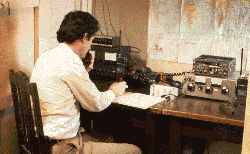 Image:
Image: VK3CKC at the microphone of VK3RI around 1984.
Article Begins: An entry calling for persons interested in forming such a Club was posted in the Victorian Railways internal publication, The Weekly Notice, for the week ending 18th May, 1926. A meeting was subsequently held on 1st July, 1926 and the Club was born.
The callsign,
VK3RI, was taken out in 1927.
During those early days, the Club broadcast music (as a lot of amateur stations did) and other items of interest from the clubrooms within the
Flinders Street Station buildings in Melbourne. Various rooms were used over the years with the present (1986) being Room 410 - next to the VRI ballroom. Dances, exhibitions and raffles were held with the proceeds, together with member subscriptions, keeping the Club in a healthy financial state. This was at the time when amateur radio in Australia, and everywhere else for that matter, was in its infancy and compared with today, was a novelty.
Around 1930, the Club was able to boast a membership in excess of 150 members.
During the Second World War years, vital Club equipment was placed in storage and some members joined the Armed Services and Merchant Navy. A few did not return.
Music broadcasting by amateur stations was prohibited in the mid 1940's and this caused a decline in membership. The advent of solid state and transistor technology, and the Club's failure to keep pace, exacerbated the decline.
In 1954, the Club's antennas which were attached to the clock tower above the Elizabeth Street - Flinders Street intersection were removed due to the Royal Visit by Queen Elizabeth II. They were apparently considered an eyesore. Beauty, of course, is in the eye of the beholder and obviously some were unable to appreciate the inherent beauty of such a construction. Membership continued to decline.
In 1959, a plea went out to any technically qualified persons who might make themselves available to an ailing club. Several transmitting and receiving items were built and some minor items were purchased. The advent of television and consequent interference caused by amateur transmissions on nearby frequencies led to even further diminishing activity.
Dances, and the revenue derived from them, ceased and more modern transmitting modes such as FM and SSB made the Club's equipment obsolete. The Club could not afford to purchase new equipment and interest turned to tape recording and music - not for transmitting.
Whilst Club activities were minimal for the next 20 years or so, regular meetings were still held which permitted the Club's existence to be continuous. Transmitting and receiving equipment remained set up and gathering dust. Capacitors dried out and knowledge of what exactly was there become obscure.
The Club became a mere shadow of its former self. I can recall, on entering the Clubroom in 1977, I felt as though I was passing through a time warp. There were things that I now know as valves, modulation transformers, carbon headphones, AR7s and heterodyne frequency meters.
Eventually, the inevitable arrived. Despite some new equipment and new blood, the end came in 1990 and the Club was wound up after 64 years. The final meeting occurred June 2nd, 1990.
Article Ends.
The following details have been extracted from various reports and documents produced by the Club. In reading the documents I can't help but get the feeling that, especially in the latter years, there may have been a degree of creative journalism applied in order to have something to print. It's just a feeling.
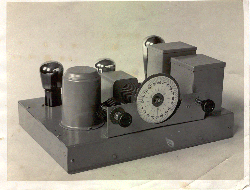 Image:
Image: The VRI 3 Valve Receiver.
1928 - Membership has increased to such an extent that the Committee has had to arrange a Beginners' Class under a competent instructor as well as a Morse class. Now affiliated with the
Wireless Institute of Australia. A successful week long Wireless Exhibition was held. A strong financial position permits the purchase of "most up-to-date equipment" including a broadcasting microphone as used by 'A' Class stations. A committee member designs the VRI 3 Valve Receiver "proving to be one of the finest 3 valve receivers to date".
1929 - The 3RI experimental transmitting station is now operating and "ranks with the best of amateur stations" and is popular with the listening public. The Club plans to form Country Centres and hopes to present a scheme to the VRI Council. Beginners Classes are being held one night each month. Lectures are also provided one night each month obtaining "the very best lecturers" in Melbourne and Sydney.
1930 - Another successful year. Another exhibition in the Concert Hall and the Executive has imporoved the Club's apparatus which is now valued at 200 pounds.
1931 - Owing to the financial depression in the Railway Department, it was expected that membership would decline. The decline was not as bad as expected and a membership drive resulted in regaining some lost members and membership approached the 200 mark. The Club's amplifier was rebuilt which greatly improved the quality and output of the transmitter and, at the present, 3RI is one of the most popular stations on the air. It has been found necessary to appoint a member to attend the telephones each Sunday as many listeners ring the station with requests. Features among the year's activities has been the building of thirty all-electric sets in the Club's workshop and the formation of a shortwave section. A shortwave transmitter will be built shortly. It is interesting to note that 3,792 reports were received from listeners on the station's transmission from distant listeners including New Zealand and the Northern Territory.
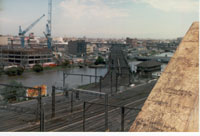 Image:
Image: The Flinders Street Station arrival tracks facing the now closed St Kilda and Port Melbourne lines.
1948 - The year was devoted largely to re-building the transmitter to 100 watts output but this did not generally interfere with the general transmission conducted on 20 and 40 metres. Confirmation reports disclose that the transmissions reached all Australian states and were also heard in America. Local interference is still a problem (electric railway supply and signalling). The Committe has already erected five different types of aerials and installed filter circuits and noise eliminators to reduce the interference. It is feared that no real DX work is possible until the noise is overcome. SOme duplex work on 6 and 40 metres.
1949 - Flinders Street Station repair work interferes with devising an aerial system to reduce noise. 170 contacts made on 6m for the year.
1950 - Not a great deal of activity due to the station repair work.
1951 - A few small alterations to equipment, a new BFO for 40 metres, the 40 metre aerial is renewed and the 6m transmitter received some attention.
1952 - Most equipment is either re-built or overhauled. The 6m power supply was rearranged and now there are two supplies. Another power supply is under construction for the 40m transmitter.
1953 - The Club now has a dual-wave converter for 6m and a dual-wave receiver will be installed soon. Alterations to the 40m aerial is holding up transmissions on that band.
1954 - ALterations to room layout. Three more coil boxes are purchased for the AR7 - completing the set. The 40m aerial is removed for the Royal Visit of Queen Elizabeth II. The 1 metre band received some considerable use and further activities are planned. Many contacts made on 6m.
1955 - The Club is in the process of trying a new layout with each transmitter independently housed and the receivers, wave meters and aerial switching grouped for convenience. Activity on the 20, 40 and 80 metre bands has been temporarily abandoned due to dismantling aerials to permit decorations for the Royal Visit and Centenary celebrations. The aerials will probably not be re-erected until after the 1956 Olympic Games.
1956 - The Club purchases a "versatile" signal generator, an indicator unit, a Rebecca tuning unit to enable experimental TV work. Transmitting activities confined to 56 and 288 Megacycle bands.
1957 - New valves and "valve replacements" are purchased. Not much activity.
1958 - Considerable activity due to a decision to rehouse the transmitters. Soon back in operation on the 1m, 2m and 6m bands. HF bands are out of action until the "long" antenna is re-erected.
1959 - HF operation is recommenced.
1960 - A new 2m transmitter, a 2m crystal-locked converter and a five element Yagi antenna. A crystal-locked converter for the 6m band and a long wire antenna for the 20, 40 and 80m bands. The Clubroom is repainted in "modern colours".
1961 - A bit more work on the converters and a GDO.
QSL card from 1961.
1962 - The AR7 is given an overhaul. A new power pack for the 522 is almost completed.
1963 - The 522 is now back on the 2m band. A type 53 transmitter and aerial tuning unit was purchased as well as a signal generator.
1964 - Not a great deal of activity.
1965 - Most transmissions confined to the 2m and 6m bands due to power supply constraints.
1966 - Work commenced on the 6m and 10m bands to increase coverage. Several members built a heavy duty welder that, although personal property, is available for use by Club members. One single heavy duty power supply and modulator is built for use on all bands.
1967 - Club finances affected by the cessation of fund raising dances. A high quality wavemeter and other equipment is donated to the Club. A small donation is made to the I.T.U. Conference fund.
1968 - A BC221 frequency meter is donated to the Club. A new 144 Megacycle converter is constructed and the AR7 is again overhauled. Transmissions are now on 144, 14, 7 and 3.5 Megacycles.
1969 - Not a great deal of activity due mainly to the lack of funds.
1970 - Repaired a number of transistor and valve radios and a television receiver. Electrical interference still a problem.
1971 - A new 144 Megacycle converter is constructed. Interference from advertising signs and other obstructions restrict HF operation.
1972 - Limited transmitting.
1973 - Mainly 2m transmissions.
1974 - Mainly lectures and demonstrations of transistor equipment. Some 2m transmissions.
1975 - Not much activity.
1976 - The AR7 overhauled.
1977 - A modern power supply for the AR7. An SSB transmitter, antenna and transverter is commenced. Participated in the John Moyle National Field Day at The Patch in the Dandenongs.
1978 - A 27MHz SSB transceiver is purchased. A power supply is constructed.
1979 - Frequency range of the 27MHz transceiver is extended.
1980 - Mobile transmitters used on the 2, 6 and 10m bands in the National Field Day at Burke's Lookout in the Dandenongs.
1981 - Not much activity.
1982 - HF transmitting antenna modifications.
QSL cards from 1986.
This page will be expanded as time permits.

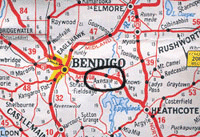


 Image: VK3CKC at the microphone of VK3RI around 1984.
Image: VK3CKC at the microphone of VK3RI around 1984. Image: The VRI 3 Valve Receiver.
Image: The VRI 3 Valve Receiver.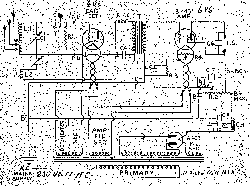 Image: The VRI 3 Valve Receiver circuit.
Image: The VRI 3 Valve Receiver circuit. Image: The Flinders Street Station arrival tracks facing the now closed St Kilda and Port Melbourne lines.
Image: The Flinders Street Station arrival tracks facing the now closed St Kilda and Port Melbourne lines.